Enterprise Architecture, Strategy & Governance: Introduction Report
VerifiedAdded on 2021/06/14
|10
|2750
|210
Report
AI Summary
This report provides an introduction to Enterprise Architecture, Strategy, and Governance, emphasizing its importance in modern business operations. It explores how Enterprise Architecture merges business and information systems to improve productivity and reduce costs. The report defines Enterprise Architecture, discusses its integration with IT governance, and highlights the roles of computer science and information systems in its development. It also touches upon SDLC and the roles of various stakeholders in EA governance, including company managers, IT staff, and vendors. The report emphasizes data security, administration, and customization. The advantages of Enterprise Architecture, such as documentation availability, integration of business processes, and data unification are highlighted. The report concludes with a strategic analysis and case study to illustrate the implementation of Enterprise Architecture, including mission statements, project objectives, situational analysis (SWOT), and strategic formation. The report references several key publications in the field and emphasizes the importance of ongoing monitoring and surveys for successful implementation.
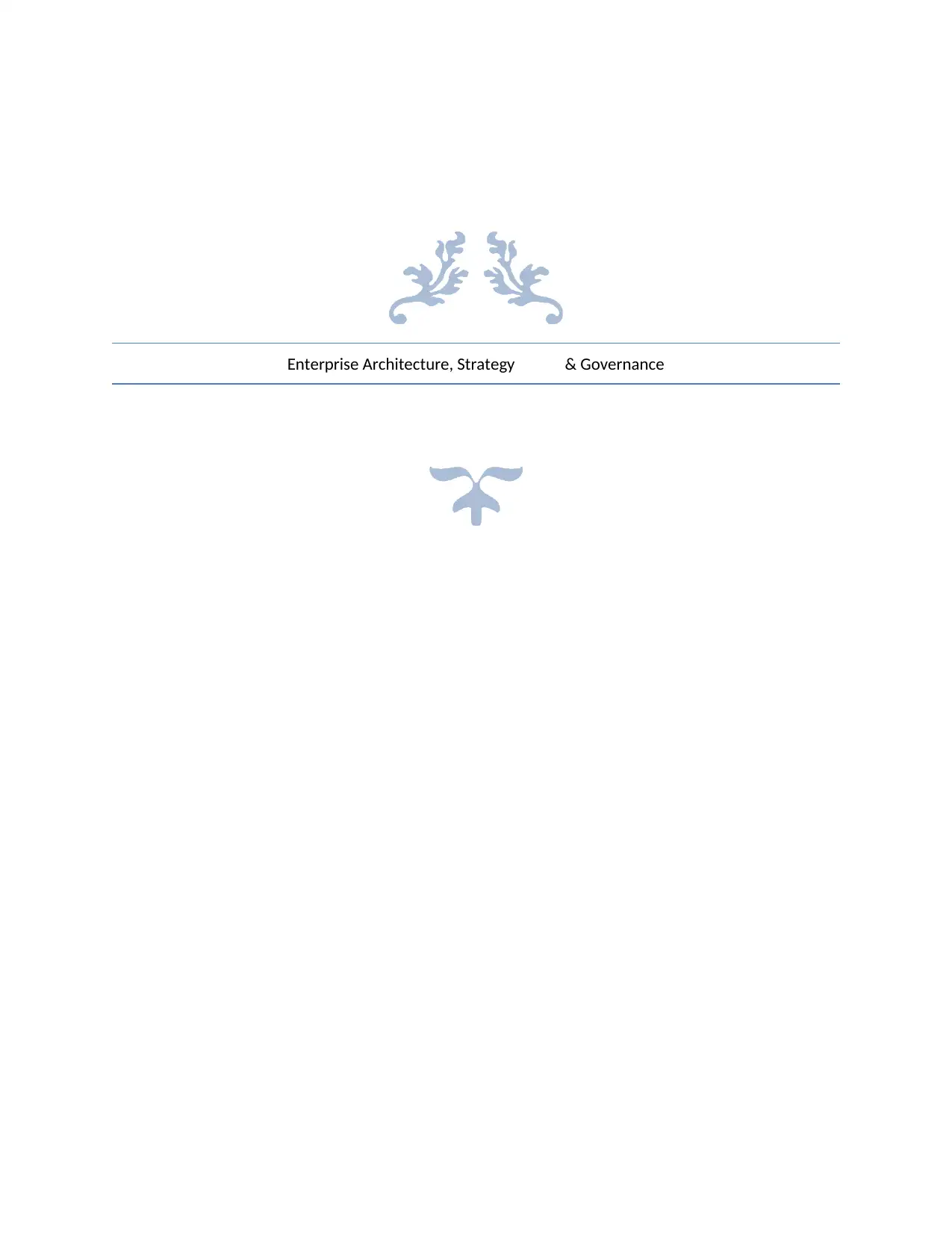
Enterprise Architecture, Strategy & Governance
Paraphrase This Document
Need a fresh take? Get an instant paraphrase of this document with our AI Paraphraser
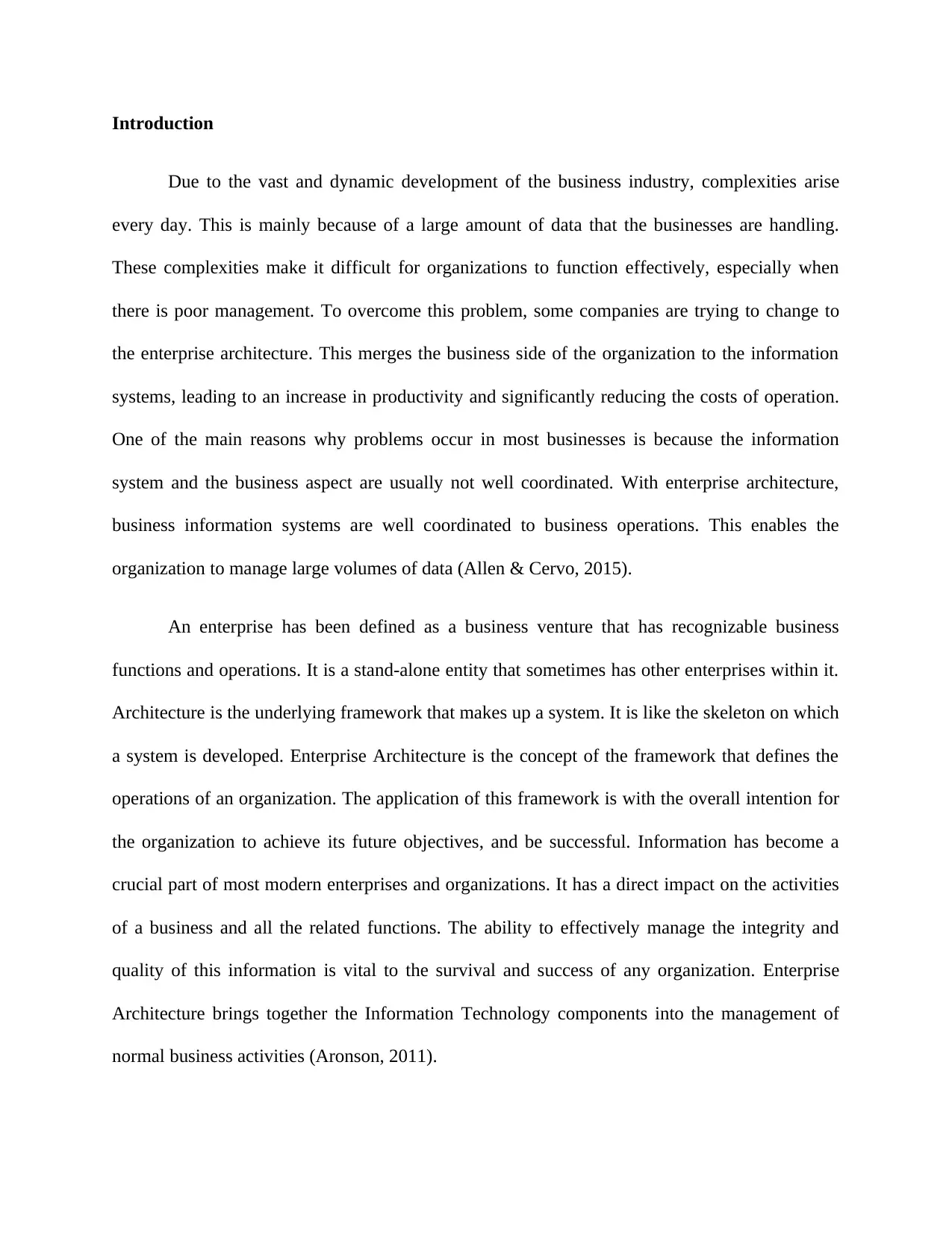
Introduction
Due to the vast and dynamic development of the business industry, complexities arise
every day. This is mainly because of a large amount of data that the businesses are handling.
These complexities make it difficult for organizations to function effectively, especially when
there is poor management. To overcome this problem, some companies are trying to change to
the enterprise architecture. This merges the business side of the organization to the information
systems, leading to an increase in productivity and significantly reducing the costs of operation.
One of the main reasons why problems occur in most businesses is because the information
system and the business aspect are usually not well coordinated. With enterprise architecture,
business information systems are well coordinated to business operations. This enables the
organization to manage large volumes of data (Allen & Cervo, 2015).
An enterprise has been defined as a business venture that has recognizable business
functions and operations. It is a stand-alone entity that sometimes has other enterprises within it.
Architecture is the underlying framework that makes up a system. It is like the skeleton on which
a system is developed. Enterprise Architecture is the concept of the framework that defines the
operations of an organization. The application of this framework is with the overall intention for
the organization to achieve its future objectives, and be successful. Information has become a
crucial part of most modern enterprises and organizations. It has a direct impact on the activities
of a business and all the related functions. The ability to effectively manage the integrity and
quality of this information is vital to the survival and success of any organization. Enterprise
Architecture brings together the Information Technology components into the management of
normal business activities (Aronson, 2011).
Due to the vast and dynamic development of the business industry, complexities arise
every day. This is mainly because of a large amount of data that the businesses are handling.
These complexities make it difficult for organizations to function effectively, especially when
there is poor management. To overcome this problem, some companies are trying to change to
the enterprise architecture. This merges the business side of the organization to the information
systems, leading to an increase in productivity and significantly reducing the costs of operation.
One of the main reasons why problems occur in most businesses is because the information
system and the business aspect are usually not well coordinated. With enterprise architecture,
business information systems are well coordinated to business operations. This enables the
organization to manage large volumes of data (Allen & Cervo, 2015).
An enterprise has been defined as a business venture that has recognizable business
functions and operations. It is a stand-alone entity that sometimes has other enterprises within it.
Architecture is the underlying framework that makes up a system. It is like the skeleton on which
a system is developed. Enterprise Architecture is the concept of the framework that defines the
operations of an organization. The application of this framework is with the overall intention for
the organization to achieve its future objectives, and be successful. Information has become a
crucial part of most modern enterprises and organizations. It has a direct impact on the activities
of a business and all the related functions. The ability to effectively manage the integrity and
quality of this information is vital to the survival and success of any organization. Enterprise
Architecture brings together the Information Technology components into the management of
normal business activities (Aronson, 2011).
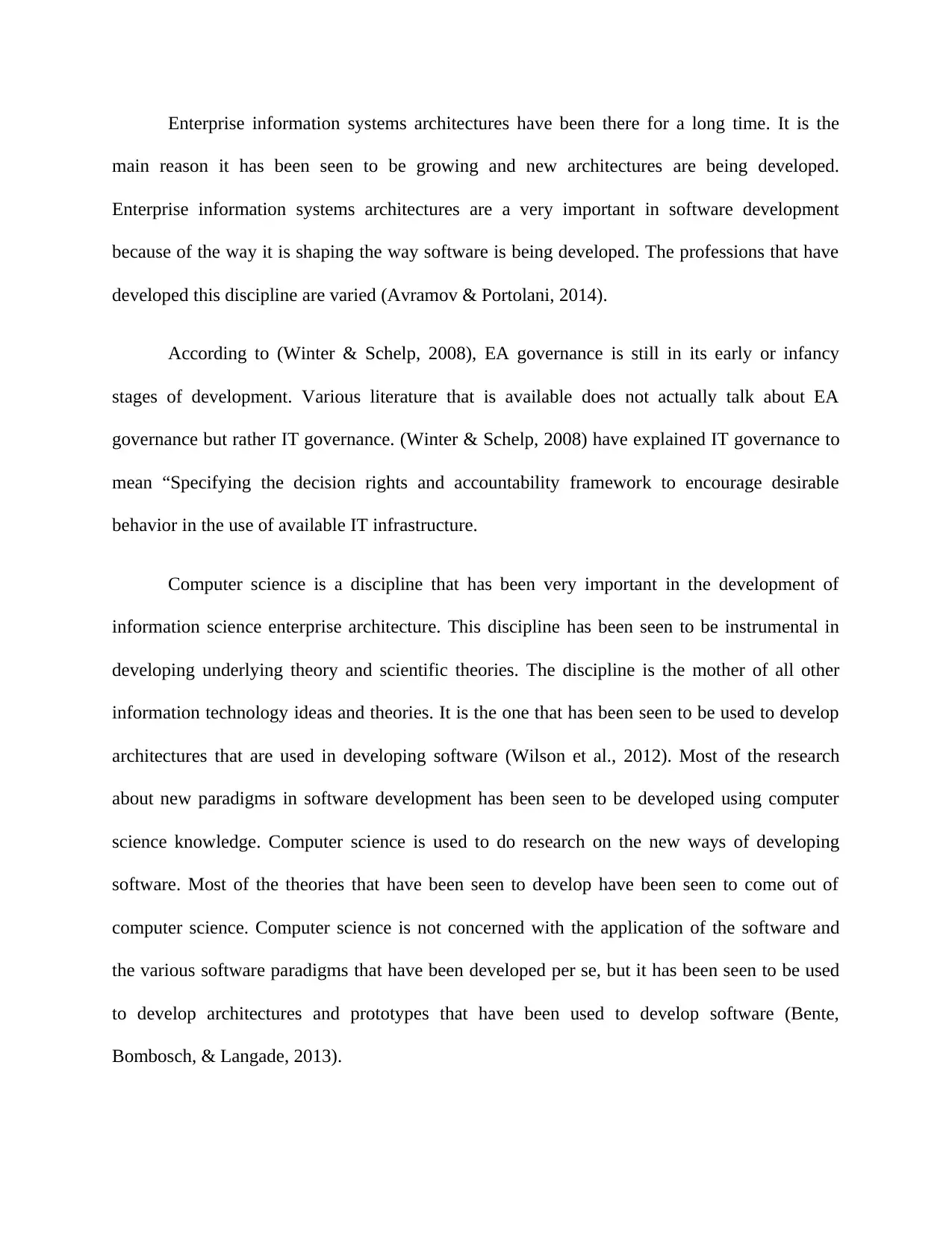
Enterprise information systems architectures have been there for a long time. It is the
main reason it has been seen to be growing and new architectures are being developed.
Enterprise information systems architectures are a very important in software development
because of the way it is shaping the way software is being developed. The professions that have
developed this discipline are varied (Avramov & Portolani, 2014).
According to (Winter & Schelp, 2008), EA governance is still in its early or infancy
stages of development. Various literature that is available does not actually talk about EA
governance but rather IT governance. (Winter & Schelp, 2008) have explained IT governance to
mean “Specifying the decision rights and accountability framework to encourage desirable
behavior in the use of available IT infrastructure.
Computer science is a discipline that has been very important in the development of
information science enterprise architecture. This discipline has been seen to be instrumental in
developing underlying theory and scientific theories. The discipline is the mother of all other
information technology ideas and theories. It is the one that has been seen to be used to develop
architectures that are used in developing software (Wilson et al., 2012). Most of the research
about new paradigms in software development has been seen to be developed using computer
science knowledge. Computer science is used to do research on the new ways of developing
software. Most of the theories that have been seen to develop have been seen to come out of
computer science. Computer science is not concerned with the application of the software and
the various software paradigms that have been developed per se, but it has been seen to be used
to develop architectures and prototypes that have been used to develop software (Bente,
Bombosch, & Langade, 2013).
main reason it has been seen to be growing and new architectures are being developed.
Enterprise information systems architectures are a very important in software development
because of the way it is shaping the way software is being developed. The professions that have
developed this discipline are varied (Avramov & Portolani, 2014).
According to (Winter & Schelp, 2008), EA governance is still in its early or infancy
stages of development. Various literature that is available does not actually talk about EA
governance but rather IT governance. (Winter & Schelp, 2008) have explained IT governance to
mean “Specifying the decision rights and accountability framework to encourage desirable
behavior in the use of available IT infrastructure.
Computer science is a discipline that has been very important in the development of
information science enterprise architecture. This discipline has been seen to be instrumental in
developing underlying theory and scientific theories. The discipline is the mother of all other
information technology ideas and theories. It is the one that has been seen to be used to develop
architectures that are used in developing software (Wilson et al., 2012). Most of the research
about new paradigms in software development has been seen to be developed using computer
science knowledge. Computer science is used to do research on the new ways of developing
software. Most of the theories that have been seen to develop have been seen to come out of
computer science. Computer science is not concerned with the application of the software and
the various software paradigms that have been developed per se, but it has been seen to be used
to develop architectures and prototypes that have been used to develop software (Bente,
Bombosch, & Langade, 2013).
⊘ This is a preview!⊘
Do you want full access?
Subscribe today to unlock all pages.

Trusted by 1+ million students worldwide
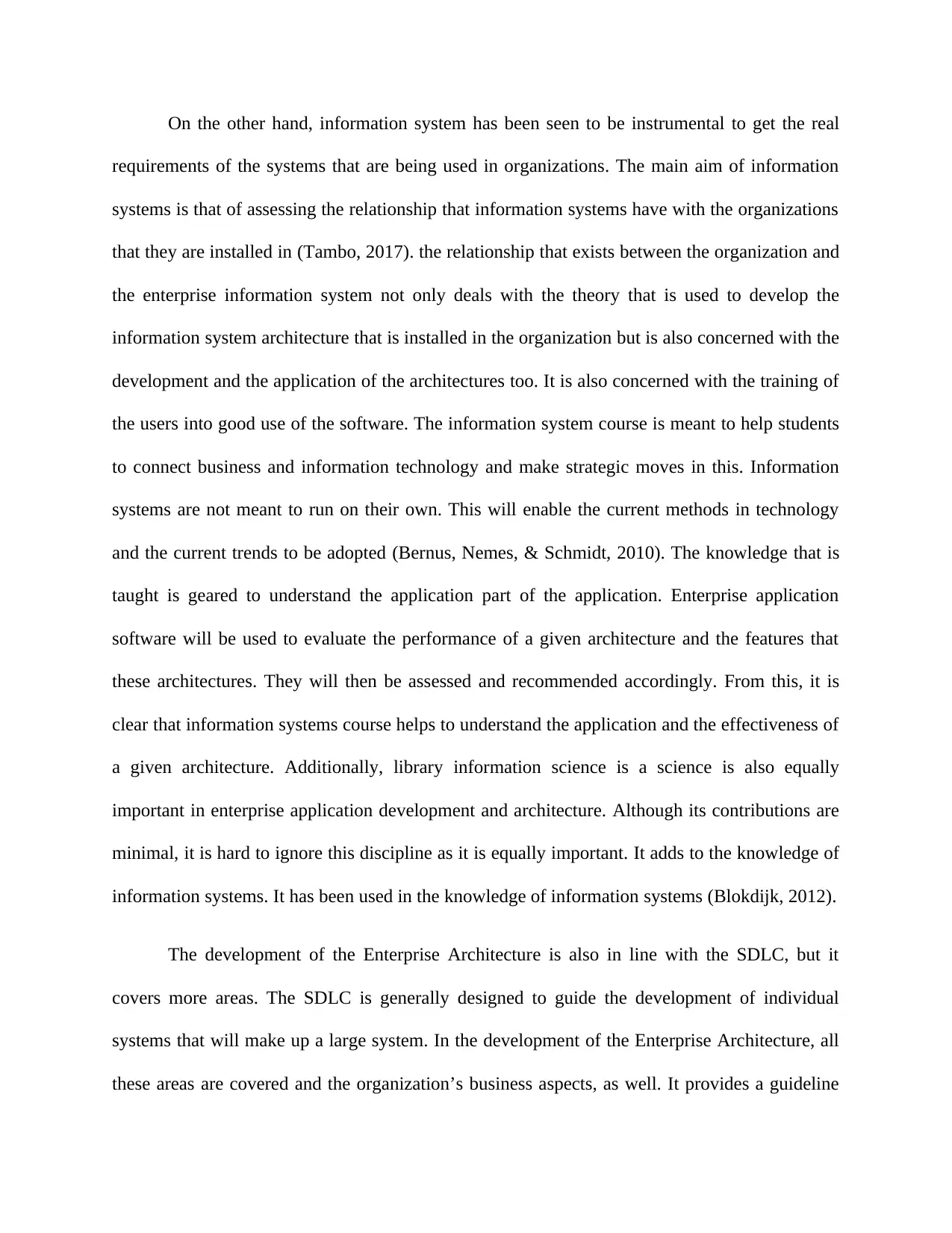
On the other hand, information system has been seen to be instrumental to get the real
requirements of the systems that are being used in organizations. The main aim of information
systems is that of assessing the relationship that information systems have with the organizations
that they are installed in (Tambo, 2017). the relationship that exists between the organization and
the enterprise information system not only deals with the theory that is used to develop the
information system architecture that is installed in the organization but is also concerned with the
development and the application of the architectures too. It is also concerned with the training of
the users into good use of the software. The information system course is meant to help students
to connect business and information technology and make strategic moves in this. Information
systems are not meant to run on their own. This will enable the current methods in technology
and the current trends to be adopted (Bernus, Nemes, & Schmidt, 2010). The knowledge that is
taught is geared to understand the application part of the application. Enterprise application
software will be used to evaluate the performance of a given architecture and the features that
these architectures. They will then be assessed and recommended accordingly. From this, it is
clear that information systems course helps to understand the application and the effectiveness of
a given architecture. Additionally, library information science is a science is also equally
important in enterprise application development and architecture. Although its contributions are
minimal, it is hard to ignore this discipline as it is equally important. It adds to the knowledge of
information systems. It has been used in the knowledge of information systems (Blokdijk, 2012).
The development of the Enterprise Architecture is also in line with the SDLC, but it
covers more areas. The SDLC is generally designed to guide the development of individual
systems that will make up a large system. In the development of the Enterprise Architecture, all
these areas are covered and the organization’s business aspects, as well. It provides a guideline
requirements of the systems that are being used in organizations. The main aim of information
systems is that of assessing the relationship that information systems have with the organizations
that they are installed in (Tambo, 2017). the relationship that exists between the organization and
the enterprise information system not only deals with the theory that is used to develop the
information system architecture that is installed in the organization but is also concerned with the
development and the application of the architectures too. It is also concerned with the training of
the users into good use of the software. The information system course is meant to help students
to connect business and information technology and make strategic moves in this. Information
systems are not meant to run on their own. This will enable the current methods in technology
and the current trends to be adopted (Bernus, Nemes, & Schmidt, 2010). The knowledge that is
taught is geared to understand the application part of the application. Enterprise application
software will be used to evaluate the performance of a given architecture and the features that
these architectures. They will then be assessed and recommended accordingly. From this, it is
clear that information systems course helps to understand the application and the effectiveness of
a given architecture. Additionally, library information science is a science is also equally
important in enterprise application development and architecture. Although its contributions are
minimal, it is hard to ignore this discipline as it is equally important. It adds to the knowledge of
information systems. It has been used in the knowledge of information systems (Blokdijk, 2012).
The development of the Enterprise Architecture is also in line with the SDLC, but it
covers more areas. The SDLC is generally designed to guide the development of individual
systems that will make up a large system. In the development of the Enterprise Architecture, all
these areas are covered and the organization’s business aspects, as well. It provides a guideline
Paraphrase This Document
Need a fresh take? Get an instant paraphrase of this document with our AI Paraphraser
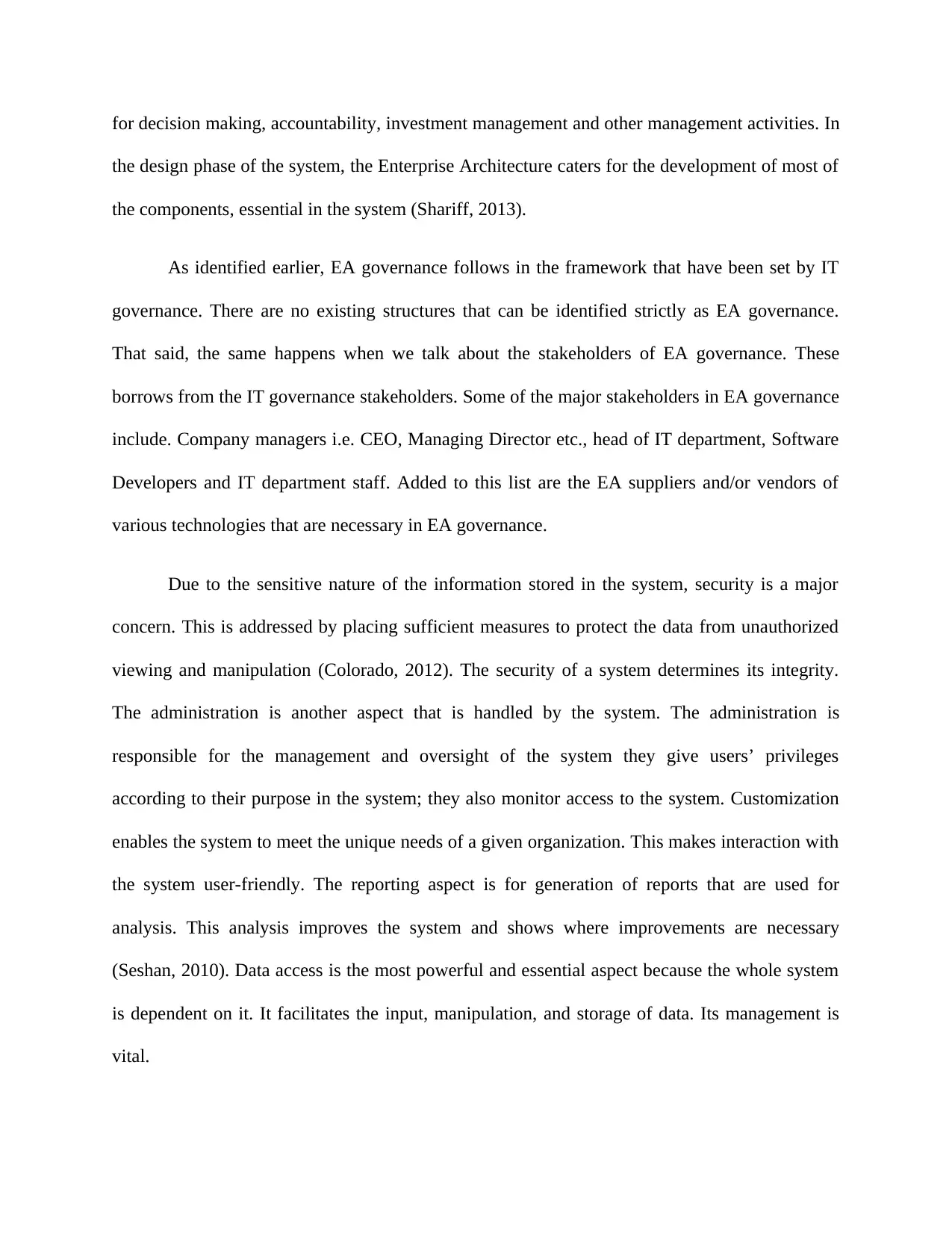
for decision making, accountability, investment management and other management activities. In
the design phase of the system, the Enterprise Architecture caters for the development of most of
the components, essential in the system (Shariff, 2013).
As identified earlier, EA governance follows in the framework that have been set by IT
governance. There are no existing structures that can be identified strictly as EA governance.
That said, the same happens when we talk about the stakeholders of EA governance. These
borrows from the IT governance stakeholders. Some of the major stakeholders in EA governance
include. Company managers i.e. CEO, Managing Director etc., head of IT department, Software
Developers and IT department staff. Added to this list are the EA suppliers and/or vendors of
various technologies that are necessary in EA governance.
Due to the sensitive nature of the information stored in the system, security is a major
concern. This is addressed by placing sufficient measures to protect the data from unauthorized
viewing and manipulation (Colorado, 2012). The security of a system determines its integrity.
The administration is another aspect that is handled by the system. The administration is
responsible for the management and oversight of the system they give users’ privileges
according to their purpose in the system; they also monitor access to the system. Customization
enables the system to meet the unique needs of a given organization. This makes interaction with
the system user-friendly. The reporting aspect is for generation of reports that are used for
analysis. This analysis improves the system and shows where improvements are necessary
(Seshan, 2010). Data access is the most powerful and essential aspect because the whole system
is dependent on it. It facilitates the input, manipulation, and storage of data. Its management is
vital.
the design phase of the system, the Enterprise Architecture caters for the development of most of
the components, essential in the system (Shariff, 2013).
As identified earlier, EA governance follows in the framework that have been set by IT
governance. There are no existing structures that can be identified strictly as EA governance.
That said, the same happens when we talk about the stakeholders of EA governance. These
borrows from the IT governance stakeholders. Some of the major stakeholders in EA governance
include. Company managers i.e. CEO, Managing Director etc., head of IT department, Software
Developers and IT department staff. Added to this list are the EA suppliers and/or vendors of
various technologies that are necessary in EA governance.
Due to the sensitive nature of the information stored in the system, security is a major
concern. This is addressed by placing sufficient measures to protect the data from unauthorized
viewing and manipulation (Colorado, 2012). The security of a system determines its integrity.
The administration is another aspect that is handled by the system. The administration is
responsible for the management and oversight of the system they give users’ privileges
according to their purpose in the system; they also monitor access to the system. Customization
enables the system to meet the unique needs of a given organization. This makes interaction with
the system user-friendly. The reporting aspect is for generation of reports that are used for
analysis. This analysis improves the system and shows where improvements are necessary
(Seshan, 2010). Data access is the most powerful and essential aspect because the whole system
is dependent on it. It facilitates the input, manipulation, and storage of data. Its management is
vital.
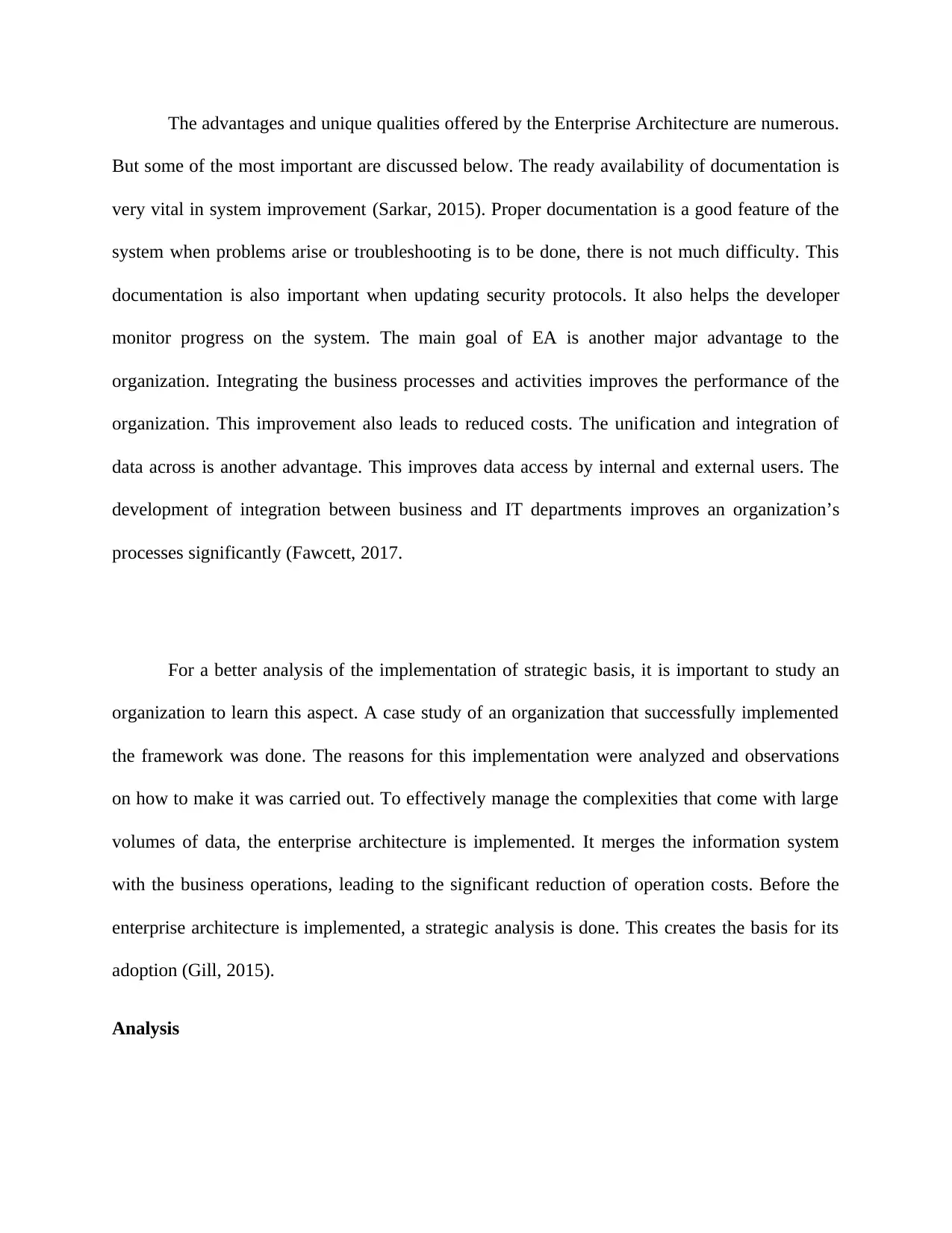
The advantages and unique qualities offered by the Enterprise Architecture are numerous.
But some of the most important are discussed below. The ready availability of documentation is
very vital in system improvement (Sarkar, 2015). Proper documentation is a good feature of the
system when problems arise or troubleshooting is to be done, there is not much difficulty. This
documentation is also important when updating security protocols. It also helps the developer
monitor progress on the system. The main goal of EA is another major advantage to the
organization. Integrating the business processes and activities improves the performance of the
organization. This improvement also leads to reduced costs. The unification and integration of
data across is another advantage. This improves data access by internal and external users. The
development of integration between business and IT departments improves an organization’s
processes significantly (Fawcett, 2017.
For a better analysis of the implementation of strategic basis, it is important to study an
organization to learn this aspect. A case study of an organization that successfully implemented
the framework was done. The reasons for this implementation were analyzed and observations
on how to make it was carried out. To effectively manage the complexities that come with large
volumes of data, the enterprise architecture is implemented. It merges the information system
with the business operations, leading to the significant reduction of operation costs. Before the
enterprise architecture is implemented, a strategic analysis is done. This creates the basis for its
adoption (Gill, 2015).
Analysis
But some of the most important are discussed below. The ready availability of documentation is
very vital in system improvement (Sarkar, 2015). Proper documentation is a good feature of the
system when problems arise or troubleshooting is to be done, there is not much difficulty. This
documentation is also important when updating security protocols. It also helps the developer
monitor progress on the system. The main goal of EA is another major advantage to the
organization. Integrating the business processes and activities improves the performance of the
organization. This improvement also leads to reduced costs. The unification and integration of
data across is another advantage. This improves data access by internal and external users. The
development of integration between business and IT departments improves an organization’s
processes significantly (Fawcett, 2017.
For a better analysis of the implementation of strategic basis, it is important to study an
organization to learn this aspect. A case study of an organization that successfully implemented
the framework was done. The reasons for this implementation were analyzed and observations
on how to make it was carried out. To effectively manage the complexities that come with large
volumes of data, the enterprise architecture is implemented. It merges the information system
with the business operations, leading to the significant reduction of operation costs. Before the
enterprise architecture is implemented, a strategic analysis is done. This creates the basis for its
adoption (Gill, 2015).
Analysis
⊘ This is a preview!⊘
Do you want full access?
Subscribe today to unlock all pages.

Trusted by 1+ million students worldwide
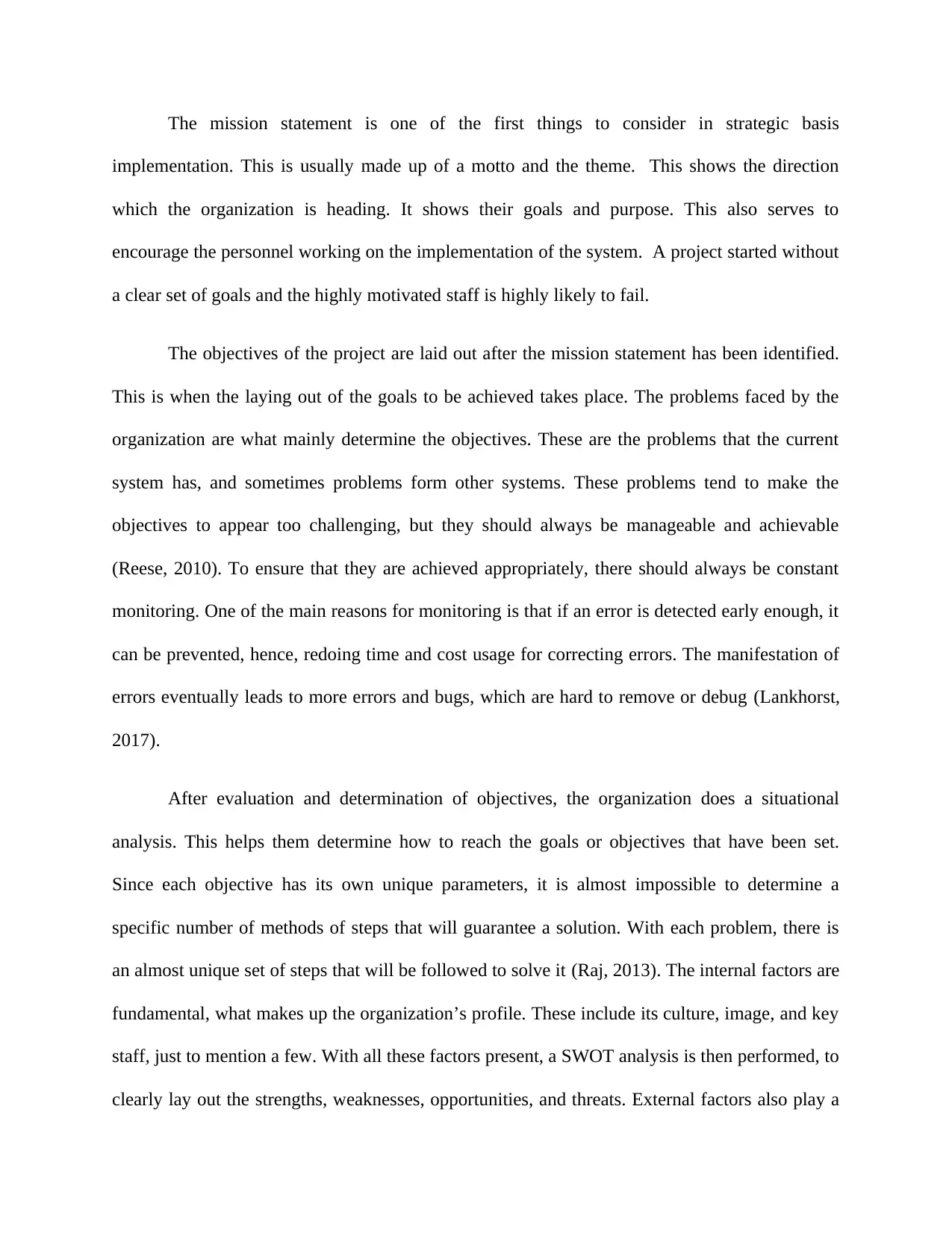
The mission statement is one of the first things to consider in strategic basis
implementation. This is usually made up of a motto and the theme. This shows the direction
which the organization is heading. It shows their goals and purpose. This also serves to
encourage the personnel working on the implementation of the system. A project started without
a clear set of goals and the highly motivated staff is highly likely to fail.
The objectives of the project are laid out after the mission statement has been identified.
This is when the laying out of the goals to be achieved takes place. The problems faced by the
organization are what mainly determine the objectives. These are the problems that the current
system has, and sometimes problems form other systems. These problems tend to make the
objectives to appear too challenging, but they should always be manageable and achievable
(Reese, 2010). To ensure that they are achieved appropriately, there should always be constant
monitoring. One of the main reasons for monitoring is that if an error is detected early enough, it
can be prevented, hence, redoing time and cost usage for correcting errors. The manifestation of
errors eventually leads to more errors and bugs, which are hard to remove or debug (Lankhorst,
2017).
After evaluation and determination of objectives, the organization does a situational
analysis. This helps them determine how to reach the goals or objectives that have been set.
Since each objective has its own unique parameters, it is almost impossible to determine a
specific number of methods of steps that will guarantee a solution. With each problem, there is
an almost unique set of steps that will be followed to solve it (Raj, 2013). The internal factors are
fundamental, what makes up the organization’s profile. These include its culture, image, and key
staff, just to mention a few. With all these factors present, a SWOT analysis is then performed, to
clearly lay out the strengths, weaknesses, opportunities, and threats. External factors also play a
implementation. This is usually made up of a motto and the theme. This shows the direction
which the organization is heading. It shows their goals and purpose. This also serves to
encourage the personnel working on the implementation of the system. A project started without
a clear set of goals and the highly motivated staff is highly likely to fail.
The objectives of the project are laid out after the mission statement has been identified.
This is when the laying out of the goals to be achieved takes place. The problems faced by the
organization are what mainly determine the objectives. These are the problems that the current
system has, and sometimes problems form other systems. These problems tend to make the
objectives to appear too challenging, but they should always be manageable and achievable
(Reese, 2010). To ensure that they are achieved appropriately, there should always be constant
monitoring. One of the main reasons for monitoring is that if an error is detected early enough, it
can be prevented, hence, redoing time and cost usage for correcting errors. The manifestation of
errors eventually leads to more errors and bugs, which are hard to remove or debug (Lankhorst,
2017).
After evaluation and determination of objectives, the organization does a situational
analysis. This helps them determine how to reach the goals or objectives that have been set.
Since each objective has its own unique parameters, it is almost impossible to determine a
specific number of methods of steps that will guarantee a solution. With each problem, there is
an almost unique set of steps that will be followed to solve it (Raj, 2013). The internal factors are
fundamental, what makes up the organization’s profile. These include its culture, image, and key
staff, just to mention a few. With all these factors present, a SWOT analysis is then performed, to
clearly lay out the strengths, weaknesses, opportunities, and threats. External factors also play a
Paraphrase This Document
Need a fresh take? Get an instant paraphrase of this document with our AI Paraphraser
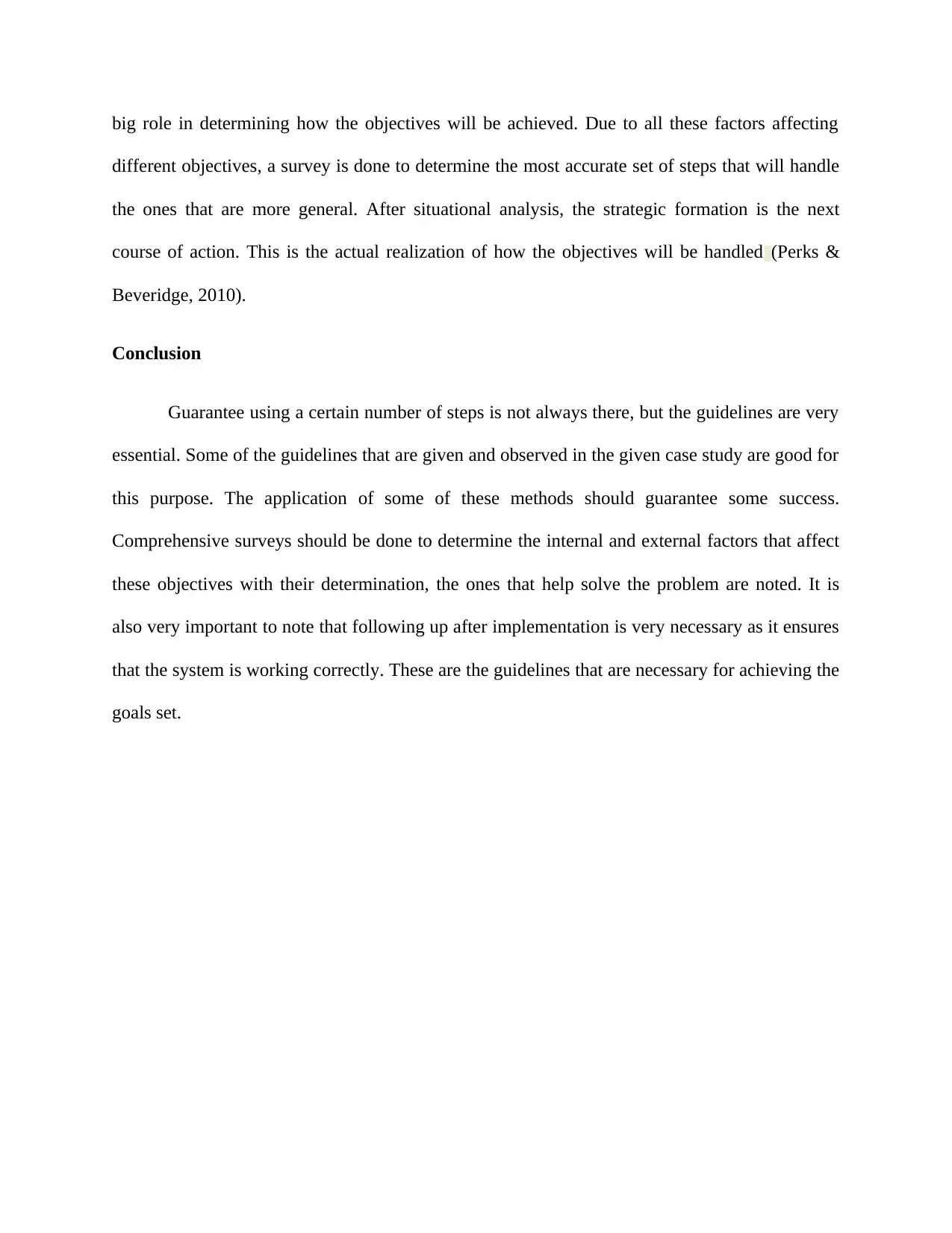
big role in determining how the objectives will be achieved. Due to all these factors affecting
different objectives, a survey is done to determine the most accurate set of steps that will handle
the ones that are more general. After situational analysis, the strategic formation is the next
course of action. This is the actual realization of how the objectives will be handled (Perks &
Beveridge, 2010).
Conclusion
Guarantee using a certain number of steps is not always there, but the guidelines are very
essential. Some of the guidelines that are given and observed in the given case study are good for
this purpose. The application of some of these methods should guarantee some success.
Comprehensive surveys should be done to determine the internal and external factors that affect
these objectives with their determination, the ones that help solve the problem are noted. It is
also very important to note that following up after implementation is very necessary as it ensures
that the system is working correctly. These are the guidelines that are necessary for achieving the
goals set.
different objectives, a survey is done to determine the most accurate set of steps that will handle
the ones that are more general. After situational analysis, the strategic formation is the next
course of action. This is the actual realization of how the objectives will be handled (Perks &
Beveridge, 2010).
Conclusion
Guarantee using a certain number of steps is not always there, but the guidelines are very
essential. Some of the guidelines that are given and observed in the given case study are good for
this purpose. The application of some of these methods should guarantee some success.
Comprehensive surveys should be done to determine the internal and external factors that affect
these objectives with their determination, the ones that help solve the problem are noted. It is
also very important to note that following up after implementation is very necessary as it ensures
that the system is working correctly. These are the guidelines that are necessary for achieving the
goals set.
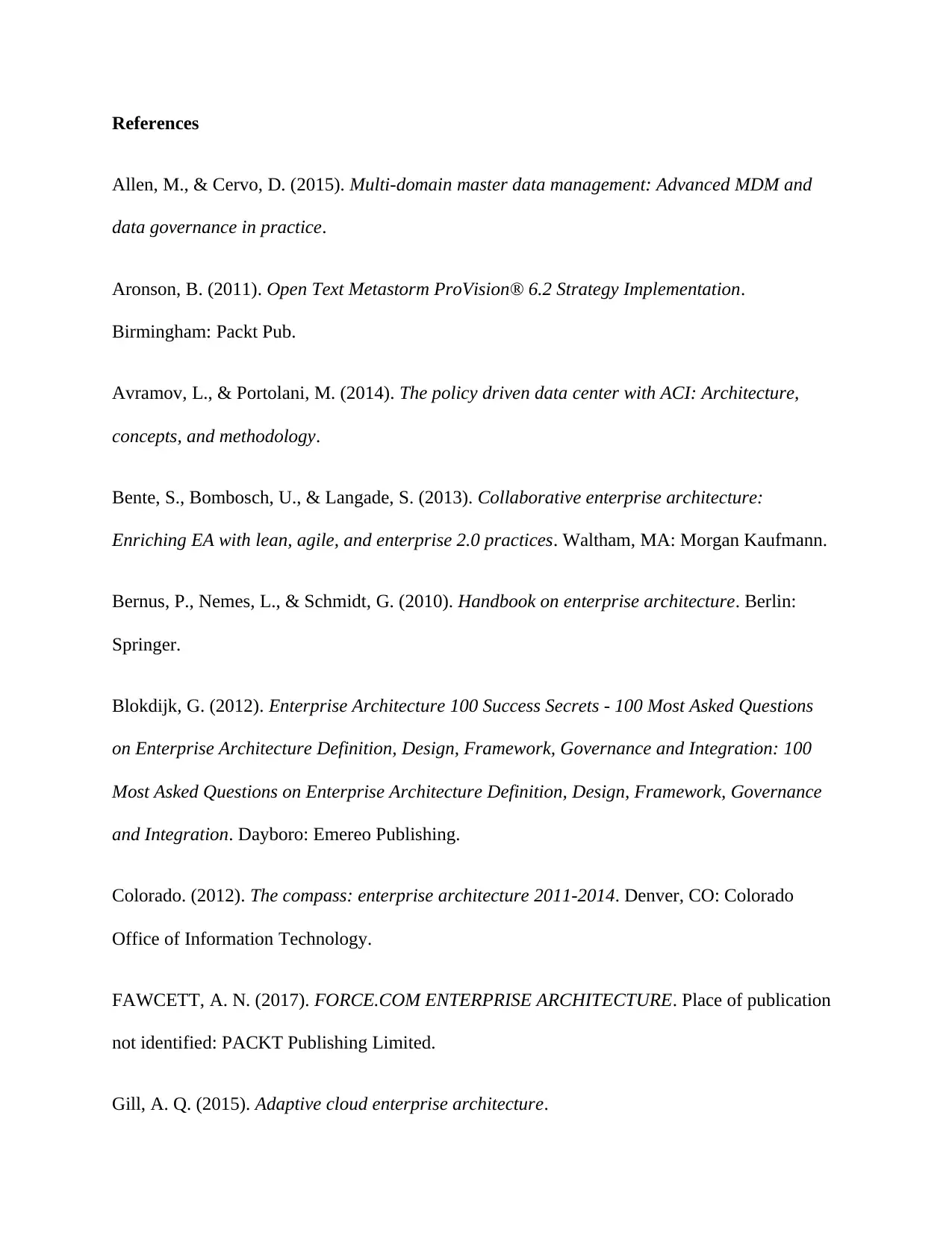
References
Allen, M., & Cervo, D. (2015). Multi-domain master data management: Advanced MDM and
data governance in practice.
Aronson, B. (2011). Open Text Metastorm ProVision® 6.2 Strategy Implementation.
Birmingham: Packt Pub.
Avramov, L., & Portolani, M. (2014). The policy driven data center with ACI: Architecture,
concepts, and methodology.
Bente, S., Bombosch, U., & Langade, S. (2013). Collaborative enterprise architecture:
Enriching EA with lean, agile, and enterprise 2.0 practices. Waltham, MA: Morgan Kaufmann.
Bernus, P., Nemes, L., & Schmidt, G. (2010). Handbook on enterprise architecture. Berlin:
Springer.
Blokdijk, G. (2012). Enterprise Architecture 100 Success Secrets - 100 Most Asked Questions
on Enterprise Architecture Definition, Design, Framework, Governance and Integration: 100
Most Asked Questions on Enterprise Architecture Definition, Design, Framework, Governance
and Integration. Dayboro: Emereo Publishing.
Colorado. (2012). The compass: enterprise architecture 2011-2014. Denver, CO: Colorado
Office of Information Technology.
FAWCETT, A. N. (2017). FORCE.COM ENTERPRISE ARCHITECTURE. Place of publication
not identified: PACKT Publishing Limited.
Gill, A. Q. (2015). Adaptive cloud enterprise architecture.
Allen, M., & Cervo, D. (2015). Multi-domain master data management: Advanced MDM and
data governance in practice.
Aronson, B. (2011). Open Text Metastorm ProVision® 6.2 Strategy Implementation.
Birmingham: Packt Pub.
Avramov, L., & Portolani, M. (2014). The policy driven data center with ACI: Architecture,
concepts, and methodology.
Bente, S., Bombosch, U., & Langade, S. (2013). Collaborative enterprise architecture:
Enriching EA with lean, agile, and enterprise 2.0 practices. Waltham, MA: Morgan Kaufmann.
Bernus, P., Nemes, L., & Schmidt, G. (2010). Handbook on enterprise architecture. Berlin:
Springer.
Blokdijk, G. (2012). Enterprise Architecture 100 Success Secrets - 100 Most Asked Questions
on Enterprise Architecture Definition, Design, Framework, Governance and Integration: 100
Most Asked Questions on Enterprise Architecture Definition, Design, Framework, Governance
and Integration. Dayboro: Emereo Publishing.
Colorado. (2012). The compass: enterprise architecture 2011-2014. Denver, CO: Colorado
Office of Information Technology.
FAWCETT, A. N. (2017). FORCE.COM ENTERPRISE ARCHITECTURE. Place of publication
not identified: PACKT Publishing Limited.
Gill, A. Q. (2015). Adaptive cloud enterprise architecture.
⊘ This is a preview!⊘
Do you want full access?
Subscribe today to unlock all pages.

Trusted by 1+ million students worldwide
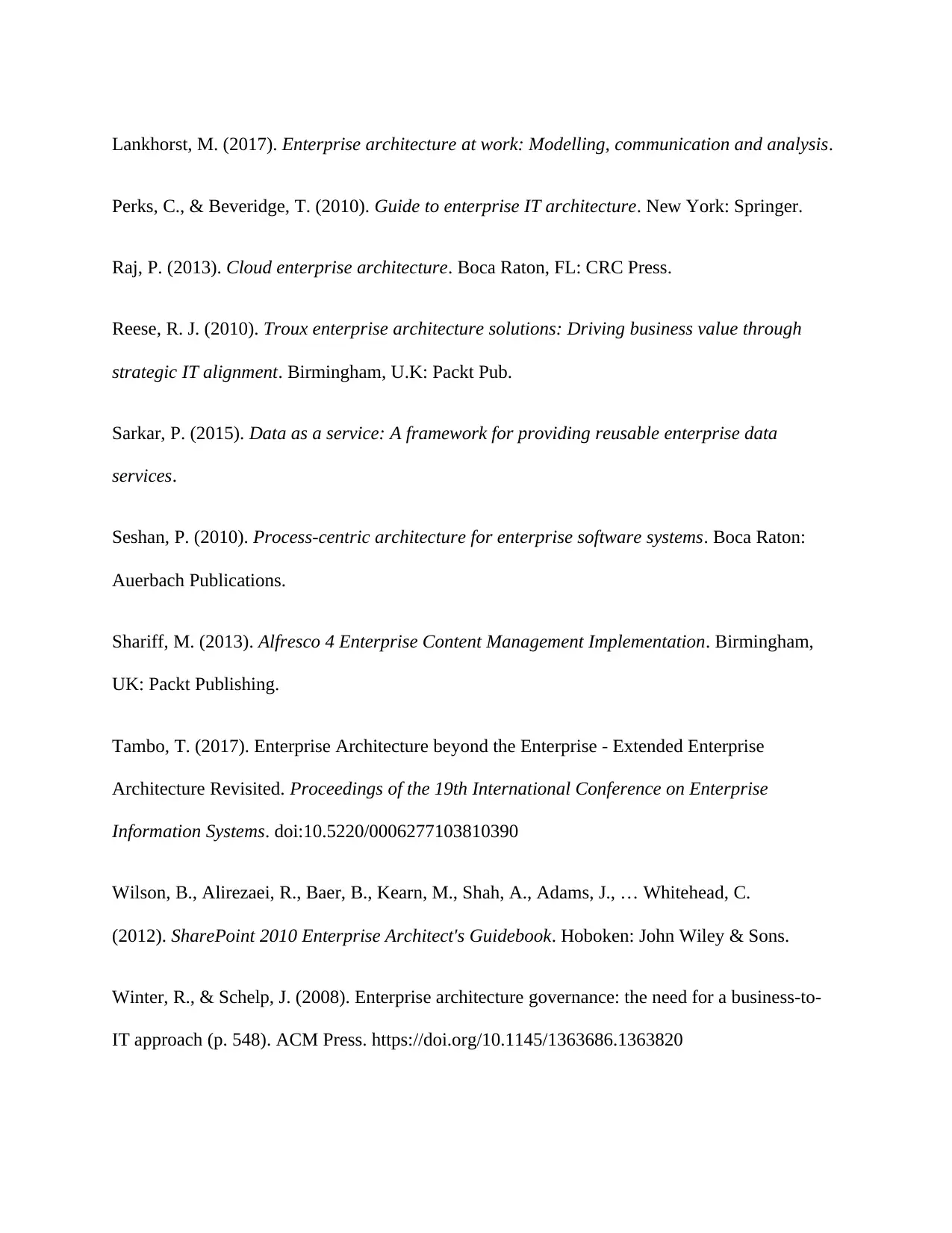
Lankhorst, M. (2017). Enterprise architecture at work: Modelling, communication and analysis.
Perks, C., & Beveridge, T. (2010). Guide to enterprise IT architecture. New York: Springer.
Raj, P. (2013). Cloud enterprise architecture. Boca Raton, FL: CRC Press.
Reese, R. J. (2010). Troux enterprise architecture solutions: Driving business value through
strategic IT alignment. Birmingham, U.K: Packt Pub.
Sarkar, P. (2015). Data as a service: A framework for providing reusable enterprise data
services.
Seshan, P. (2010). Process-centric architecture for enterprise software systems. Boca Raton:
Auerbach Publications.
Shariff, M. (2013). Alfresco 4 Enterprise Content Management Implementation. Birmingham,
UK: Packt Publishing.
Tambo, T. (2017). Enterprise Architecture beyond the Enterprise - Extended Enterprise
Architecture Revisited. Proceedings of the 19th International Conference on Enterprise
Information Systems. doi:10.5220/0006277103810390
Wilson, B., Alirezaei, R., Baer, B., Kearn, M., Shah, A., Adams, J., … Whitehead, C.
(2012). SharePoint 2010 Enterprise Architect's Guidebook. Hoboken: John Wiley & Sons.
Winter, R., & Schelp, J. (2008). Enterprise architecture governance: the need for a business-to-
IT approach (p. 548). ACM Press. https://doi.org/10.1145/1363686.1363820
Perks, C., & Beveridge, T. (2010). Guide to enterprise IT architecture. New York: Springer.
Raj, P. (2013). Cloud enterprise architecture. Boca Raton, FL: CRC Press.
Reese, R. J. (2010). Troux enterprise architecture solutions: Driving business value through
strategic IT alignment. Birmingham, U.K: Packt Pub.
Sarkar, P. (2015). Data as a service: A framework for providing reusable enterprise data
services.
Seshan, P. (2010). Process-centric architecture for enterprise software systems. Boca Raton:
Auerbach Publications.
Shariff, M. (2013). Alfresco 4 Enterprise Content Management Implementation. Birmingham,
UK: Packt Publishing.
Tambo, T. (2017). Enterprise Architecture beyond the Enterprise - Extended Enterprise
Architecture Revisited. Proceedings of the 19th International Conference on Enterprise
Information Systems. doi:10.5220/0006277103810390
Wilson, B., Alirezaei, R., Baer, B., Kearn, M., Shah, A., Adams, J., … Whitehead, C.
(2012). SharePoint 2010 Enterprise Architect's Guidebook. Hoboken: John Wiley & Sons.
Winter, R., & Schelp, J. (2008). Enterprise architecture governance: the need for a business-to-
IT approach (p. 548). ACM Press. https://doi.org/10.1145/1363686.1363820
1 out of 10
Related Documents
Your All-in-One AI-Powered Toolkit for Academic Success.
+13062052269
info@desklib.com
Available 24*7 on WhatsApp / Email
![[object Object]](/_next/static/media/star-bottom.7253800d.svg)
Unlock your academic potential
Copyright © 2020–2025 A2Z Services. All Rights Reserved. Developed and managed by ZUCOL.




